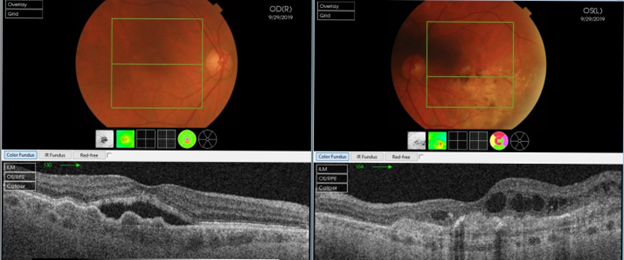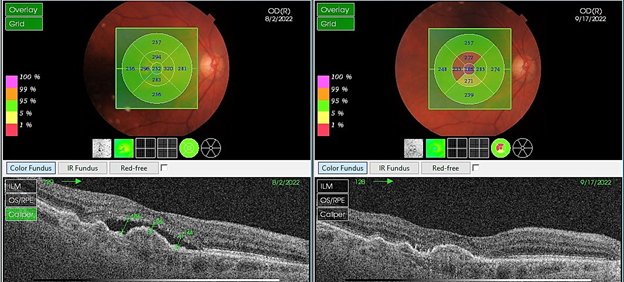Case Report
Volume 4 Issue 1 - 2022
The Subretinal Fluid Tolerance Post Faricimab injection Short Case Review study
Department of Medical Retina, Sharif Eye Center, Amman, Jordan
*Corresponding Author: Fawwaz Almamoori MD, The Subretinal Fluid Tolerance Post Faricimab injection Short Case Review study.
Received: November 07, 2022; Published: November 19, 2022
Abstract
Aim: To evaluate the efficacy of a new Anti-VEGF molecules Faricimab 6 mg (0.05ml of 120mg/ml) in resolving a refractory subretinal fluid (SRF) in wet AMD cases.
Method: we retrospectively reviewed a 64-year-old female Caucasian single eye patient, presented to our clinic on September 2019 with (wet AMD) in the right eye & advanced wet AMD with fibrosis and scar in the left eye. the patient decided to treat the right eye only, she received initially 3 loading doses of aflibercept (40 mg/ml) and then was shifted to a treat and extend regimen (T&E). Thew best corrected vision (BCA) has been improved from 0.5 to 0.8 with persistence of subretinal fluid during the treatment period. On her recent visit, the patient then shifted to Faricimab (Vabysmo 6mg).
Result: The swept source OCT (SS-OCT) image one month post Faricimab injection showed a complete resolution of subretinal fluid with improvement of vision to all 0.8 + 2.
Abbreviations: SRF=Subretinal Fluid; IRF=Intraretinal Fluid; Sub-RPE: Sub-Retinal Pigment Epithelium; Wet AMD=Wet Age-Related Macular degeneration; T&E: Treat and Extend; SS-OCT=Swept Source-Optical Coherence Tomography; BCVA=Best Corrected Visual Acuity; Ang-2=Angiopoitin-2).
Introduction
The fluid in (wet AMD) is still one of the great debates in the management of the patients with wet age-related macular degeneration (wet AMD).
The main aim in the management of the patient with neovascular wet AMD is to eliminate all the fluid in the anatomical compartments of the macula including intraretinal fluid (IRF), subretinal fluid (SRF) and sub-retinal pigment epithelium fluid (Sub-RPE) to achieve the best functional outcomes.
Whereas the negative vision impact of persisting intraretinal fluid (IRF) are undisputed. There is a more argument about the persisting subretinal fluid (SRF). The studies showed that the intraretinal fluid (IRF) negatively affected on visual outcome at the baseline and through the treatment with direct correlation with the drop and the recovery of vision [1]. But with patients who have (SRF) at the baseline they do better and the (SRF) is correlated with the better visual outcome [1,2].
The subretinal fluid (SRF) can be defined as a hyporeflective space between the neurosensory retina and the retinal pigment epithelium (RPE). It could be neovascular like in wet AMD or non-neovascular (degenerative) which has been hypothesized to be due to the loss of RPE pump, destruction in the Mueller cell or failure in the extracellular fluid resorption mechanism.
The (fluid is study) results showed that the patients with treat and extend (T&E) protocol who tolerated some subretinal fluid (SRF) achieved same visual outcome with a smaller number of injections in comparable with the treatment aimed to resolve all subretinal fluid (SRF) completely [3].
So, regarding subretinal fluid some believe that the retina should be dry completely and the other things that it is not necessary to treat and give more injections if the vision and subretinal fluid (SRF) still are stable.
Method
This is a retrospectively reviewed case of bilateral wet AMD that presented to our medical retina department at Sharif eye center, Amman, Jordan. She received intravitreal aflibercept injections for the right eye neovascular age-related macular degeneration between (September 2019 and September 2020). The best corrected vision (BCVA) of her right eye at the baseline was 0.5 and the left eye was CF=1meter (Figure 1). SS-OCT showed (SRF) of less than 200 μm with no (IRF)or sub RPE fluid. The patient initially received three monthly loading doses of aflibercept, the BCVA improved to 0.8 with reduction of sub-foveal SRF from (172 μm to 115 μm). The patient was given another two monthly injections, but the BCVA was stabilized to 0.8 with persistence of SRF (<200μm)
The patient then received according to the treat and extend regimen(T&E) a Q8 weeks injections of aflibercept that adjusted according to the stability of vision and the level of subretinal fluid SRF (5). The (SRF) during the treatment period over 2 years has been stabilized to be less than 200 μm (Figure 2). On her last visit to our clinic on September 2022 the patient was shifted to the new Anti-VEGF molecule
Faricimab (Vabysmo 6mg).
Faricimab is the most recent Anti-VEGF molecule that approved by Food and Drug administration (FDA) and European Medicines Agency (EMA) for the treatment of wet AMD and diabetic macular edema (DME). It is a humanized by bispecific monoclonal antibody that acts through the inhibition of both VEGF-A & Angiopoitin-2(Ang-2). Ang-2 has been shown to play a role in the inflammation and vascular stability in the animal models [6].
Faricimab is the most recent Anti-VEGF molecule that approved by Food and Drug administration (FDA) and European Medicines Agency (EMA) for the treatment of wet AMD and diabetic macular edema (DME). It is a humanized by bispecific monoclonal antibody that acts through the inhibition of both VEGF-A & Angiopoitin-2(Ang-2). Ang-2 has been shown to play a role in the inflammation and vascular stability in the animal models [6].
Tenaya and Lucerne trials recently showed the benefits of Ang-2 blockage through dosing up to every 16 weeks regimen which will help in reducing the treatment burden.

Figure 1: Swept Source OCT Topcon image (SS-OCT), (a) SS-OCT: showed right eye wet-AMD with sub-foveal hyporeflective space (SRF). (b): SS-OCT of left eye wet AMD with (IRF), scar and disrupted photoreceptor layer.

Figure 2: Multiple SS-OCT images of the right eye during (T&E) treatment period over two years (2019-2022) that showed (SRF) fluctuations of less than 200 μm.
Results
One month post Faricimab injection BCVA improved to 0.8 + 2 letters with complete drying out of refractory SRF on SS-OCT (Figure 3) and this effect was maintained for eight weeks. Then the patient scheduled to receive Faricimab injection every eight weeks based on her BCVA and disease activity on OCT.

Figure 3: (SS-OCT image) of the right eye before and after Faricimab injection, (a): Pre Faricimab injection SS-OCT, showed refractory SRF of average 140 μm.(b): Post Faricimab injection SS-OCT that showed complete resolution of refractory SRF.
Discussion
The neovascular WET AMD is a common cause of visual impairment in elderly aged group above the age of 50 years old. The emergence of intravitreal anti VEGF therapy has significantly improved the treatment outcomes in a patient with neovascular AMD. [8] The persistence of fluid on OCT is associated with a negative impact on vision especially when (IRF) and (SRF) are parafoveal.
The persistence of SRF in neovascular AMD could be due to the a): sub optimal treatment (inadequate frequency of injections), b): refractory to the treatment (development of scars within mature vessels, development of degeneration cysts) or tachyphylaxis, c): incorrect diagnosis. Fluid volumes decrease and increase due to the fluctuation of the disease activity.
Fluctuation in the foveal center had a negative adverse effect on visual outcome leading to the development of fibrosis and atrophy [9]. The SRF and sub RPE fluid were inconsistent with BCVA while intraretinal fluid IRF was consistently associated with the negative outcome [12].
Conclusion
The new Anti-VEGF molecules like Faricimab will open the gate for effective treatment of wet AMD with effective drying out of all macular fluid compartments with a smaller number of injections & open another debate about the tolerability of subretinal fluid.
Financial Disclosure: No financial disclosures.
References
- Sophie Riedl, Wolf-Dieter Vogl, Sebastian M Waldstein, Ursula Schmidt-Erfurth, Hrvoje Bogunovi? (2022): Impact of Intra- and Subretinal Fluid on Vision Based on Volume Quantification in the HARBOR Trial, 6 (4): 291-297.
- Jason Q Core, Maxwell Pistilli, Ebenezer Daniel, Juan E Grunwald, Cynthia A Toth, Glenn J Jaffe, Peiying Hua, Daniel F Martin, Gui-Shuang Ying, Maureen G Maguire, Comparison of Age-Related Macular Degeneration Treatments Trials Research Group (2021). Predominantly Persistent Subretinal Fluid in the Comparison of Age-Related Macular Degeneration Treatments Trials, 5(10): 962-974.
- Robyn H Guymer, Caroline M Markey, Ian L McAllister, Mark C Gillies, Alex P Hunyor, Jennifer J Arnold 6, FLUID Investigators, (2019). Tolerating Subretinal Fluid in Neovascular Age-Related Macular Degeneration Treated with Ranibizumab Using a Treat-and-Extend Regimen: FLUID Study 24-Month Results, 126(5): 723-734.
- Intravitreal Aflibercept (VEGF Trap-Eye) in Wet Age-related Macular Degeneration (2012). Jeffrey S. Heier, MD, David M. Brown,MD, Victor Chong, MD, Christian Simader, MD, Ursula Schmidt-Erfurth, MD 119(12): 2537-48.
- A Retrospective Study of Ranibizumab Treatment Regimens for Neovascular Age-Related Macular Degeneration (nAMD) in Australia and the United Kingdom, (2017). Robert L Johnston 1 2, Hans-Joachim Carius, Adrian Skelly, Alberto Ferreira, Fran Milnes, Paul Mitchell 6 34(3): 703-712.
- Efficacy, durability, and safety of intravitreal faricimab up to every 16 weeks for neovascular age-related macular degeneration (TENAYA and LUCERNE): two randomized, double-masked, phase 3, non-inferiority trials, (2022). Jeffrey S Heier, MD ,Arshad M Khanani, MD, Carlos Quezada Ruiz, MD Karen Basu, PhD, Philip J Ferrone, MD, Christopher Brittain, MBBS. Volume 399, ISSUE 10326, P729-740.
- Causes of visual impairment in people aged 75 years and older in Britain: an add-on study to the MRC Trial of Assessment and Management of Older People in the Community, (2004). J R Evans 1, A E Fletcher, R P L Wormald, MRC Trial of Assessment and Management of Older People in the Community 88(3): 365-70.
- David M Brown 1, Mark Michels, Peter K Kaiser, Jeffrey S Heier, Judy P Sy, Tsontcho Ianchulev, ANCHOR Study Group, (2009). Ranibizumab versus verteporfin photodynamic therapy for neovascular age-related macular degeneration: Two-year results of the ANCHOR study, 116(1):57-65.e5.
- Evans et al, (2019), “Associations between variation in retinal thickness and visual function”, ARVO 2019 poster.
- Sophie Riedl; Wolf-Dieter Vogl; Sebastian M Waldstein; Hrvoje Bogunovic; Ursula Schmidt-Erfurth. (2020), Fluid Persistence and its Impact on BCVA Development During the Treatment of Neovascular AMD.
- Rebecca N Evans 1, Barnaby C Reeves 1, Maureen G Maguire 2, Daniel F Martin 3, Alyson Muldrew 4, Tunde Peto 4, Chris Rogers 1, Usha Chakravarthy, (2020). Associations of Variation in Retinal Thickness With Visual Acuity and Anatomic Outcomes in Eyes With Neovascular Age-Related Macular Degeneration Lesions Treated With Anti-Vascular Endothelial Growth Factor Agents, 138(10): 1043–1051.
- Varun Chaudhary, MD, FRCS(C), Frédéric Matonti, MD, PhD, Javier Zarranz-Ventura, MD, PhD, FEBO, and Michael W. Stewart, MD§. (2022). IMPACT OF FLUID COMPARTMENTS ON FUNCTIONAL OUTCOMES FOR PATIENTS WITH NEOVASCULAR AGE-RELATED MACULAR DEGENERATION Retina. 2022 Apr; 42(4): 589–606.
Citation: Fawwaz Almamoori MD. (2022). The Subretinal Fluid Tolerance Post Faricimab injection Short Case Review study. Journal of Ophthalmology and Vision Research 4(1).
Copyright: © 2022 Fawwaz Almamoori. This is an open-access article distributed under the terms of the Creative Commons Attribution License, which permits unrestricted use, distribution, and reproduction in any medium, provided the original author and source are credited.
